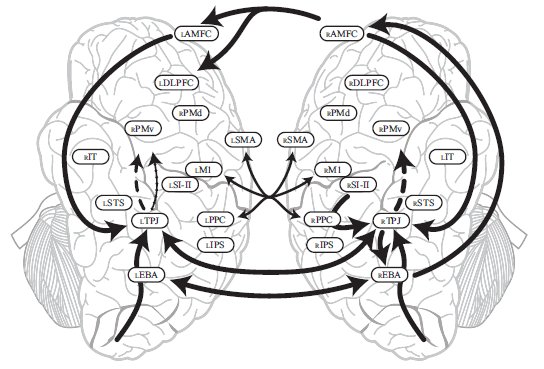
Neural Modeling of the Cortical Processes
Underlying Imitative Behaviors:
A Dynamic Neural Field Approach
My PhD work was devoted to the understanding and modeling of the neural correlates of imitative behaviors in humans by means of non-linear dynamical neural networks. My dissertation can be found here .
Abstract
Imitation is the ability to recognize, learn and reproduce the actions of others. In addition to facilitating the transmission of knowledge and skills, it has been suggested that this fundamental cognitive capacity is at the origin of other human faculties such as action understanding, empathy, mind-reading and language. Although the behavioral processes of imitation have been studied for a century in ethology and psychology, neuroscience has only started being interested in, stimulated by the discovery of a common neural substrate devoted to the recognition and production of actions, namely, the mirror neuron system. However, the existence of this system does not provide a comprehensive answer to all questions about imitation. For instance, as mirror neurons, which fire both during the observation and the execution of actions, were found in the monkey, how could the behavioral differences reported in humans be explained in terms of cortical functions and connectivity? Moreover, because of the existence of this common neural substrate, which is activated irrespectively of who is performing an action, how do humans not confuse their own actions with those of others? And finally, how could different imitative strategies and imitation levels be produced by the brain according to behavioral and neurophysiological constraints? In order to shed some light on these key questions, the approach adopted in this work is to apply the principles of computational neuroscience by developing neural models of the cortical networks involved in imitation processes.

In this thesis, the use of artificial neural networks is considered a fundamental methodology. More specifically, neural fields were chosen to be the central modeling tools since this class of neural networks have been shown to be endowed with many computational abilities, most of which were actually observed experimentally in cortical regions. Although several computational models addressing imitation have already been proposed, rare are those which consider the previously mentioned issues and especially by means of neural modeling. To fill this gap, this thesis addresses the neural mechanisms underlying several important cognitive processes. They are: a) the principle of ideomotor compatibility, by which one's own performance is influenced by observing others; b) the problem of frames of reference transformations that make it possible to put oneself into someone else's place and to simplify the sensorimotor mappings required for imitation; and c) the ability to distinguish oneself from the others to make the perceived visual signals related to oneself or to others less ambiguous. Importantly, in order to confirm or refute the neural models that are developed in this work, behavioral studies are proposed along with the predictions of the models. Finally, this thesis also provides a global model of cortical organization in which the brain pathways of imitation are highlighted. Through this synthesis, the neural processes of imitation in humans are suggested to not involve specific cortical areas only as usually believed, but instead, the sensorimotor cortex in its whole.
The contributions of this thesis are basically twofold. First, the developed neural models of the cortical networks involved in imitation contribute to a better understanding of the neural mechanisms underlying this human ability. As such, it suggests several new directions and hypotheses for research in the field of both experimental psychology and neuroscience. Secondly, this thesis also contributes directly to the field of artificial neural networks by providing new technical developments on the current knowledge of the computational power of the neural field approach.

